
Are parents cruel for allowing a child to be engulfed by the big, scary looking stranger we call Santa Claus?
The toddler above is reaching out to, presumably, Mommy to rescue him from what is, from his point of view, an abduction.
Surely, she’s just standing there telling him, “It’s alright,” or, “Stop your crying!”
But no matter what she does…her failure to “rescue” him sends a very powerful message to him.
What is it about Santa Claus — or rather, the stranger whom parents don’t even know who’s playing Santa Claus — that makes many parents lose their senses and place a crying child in Santa Claus’s lap?
Why is forcing a reluctant child into Santa Claus’s lap so important? What parents truly want to struggle with kicking legs, shrieking, and staring from other people?
Are the stakes that high? All this, just for a photo? Or is something else at play?
Some parents just want to get their child on Santa Claus’s lap without really understanding why.
What will parents miss out on, if they don’t see their child in Santa Claus’s lap?
Not all parents get caught up in this Santa Claus power struggle with their child.
Some parents don’t feel slighted when their child’s inborn “stranger-danger” alarm goes off.
These parents don’t take the Santa Claus rejection personally as a sign of disrespect to Mom or Dad.
Instead, such parents appreciate this valuable innate stranger-danger radar in their child.
These parents know that far worse things can happen in life than having a child who’s afraid to sit in Santa Claus’s lap.
I asked Judith Barr, a psychotherapist in Brookfield, CT, and author of “Power Abused, Power Healed,” about the underlying forces that compel parents to disregard a child’s fear and place him in Santa Claus’s lap. Judith says this is rooted in parents’ own childhood wounds.
Barr explains: “When we are young, we bury painful feelings. As a defense against these feelings we unconsciously (or in some cases consciously) make what I call early decisions.
“When we grow, these decisions, if we remain unaware of them, can drive our lives from ‘behind the scenes’… and may account for the power struggle.”
An example is a child with domineering parents who have unrealistic expectations of him.
When the child fails to meet these expectations, he is hollered at, berated, or even smacked.
“As he cries himself to sleep,” says Barr, “he makes a decision, consciously or unconsciously:
You have all the power NOW, Mom and Dad, but you wait! When I grow up, I’LL have all the power, and everybody’s gonna know it!
“The child then grows up…and remains unaware of this decision impacting his life.
“He becomes a parent himself… and doesn’t realize that he has transferred his early feelings for Mom and Dad onto his daughter.”
With his daughter, he often acts out the power struggle with Mom and Dad.
“When she cries as he places her on Santa Claus’s lap, he may be re-enacting in his daughter the type of fear and pain he himself experienced…or he may be acting out his early decision, proving he can control her behavior, force her to do what she is unwilling to do…just as Mom and Dad did with him, or just as he would have liked to do with them.”
If you think this is just “psycho babble,” then ask yourself why on earth parents, the very adults a young child is supposed to feel protected by and have trust in, would subject a crying child to the terror of sitting in a huge, strange-looking man’s lap?
Think of this from the child’s perspective. It can be downright terrifying. And Mommy or Daddy don’t care!

Barr also says that other factors could explain why parents would force a frightened child to sit in Santa Claus’s lap.
“The fact that some parents take photos to show to their family and friends also stems from a variety of possible reasons…perhaps it’s an unconscious ‘trophy’ or indirect ‘proof’ the parent has ‘won’ the power struggle with his/her own Mom or Dad.”
Analyzed or not, the forced Santa Claus issue ultimately serves no beneficial purpose.
Parents, imagine yourself in your child’s place, especially if you’re a woman: Imagine being forced to sit in a giant man’s lap — a man who gives you the total creeps, a man with a straggly beard and funny look in his eyes, and you’re convinced he’ll do whatever he wants with your body, and nobody is around to rescue you.
Fighting him off is not an option because he’s three feet taller and 150 pounds heavier than you.
Disclaimer: It may be tempting to assume that as a young child, I had negative experiences with Santa Claus.
But actually, my mother never got caught up in any of this; when she took me to the mall, it was strictly business; she never made me sit in Santa Claus’s lap (if for no other reason, she hated waiting in long lines).
She just didn’t get into this facet of the holidays, including the whole thing about getting the pictures taken.

 Judith Barr’s background includes a licensure as a mental health counselor in Connecticut, New York and Florida.
Judith Barr’s background includes a licensure as a mental health counselor in Connecticut, New York and Florida.







































